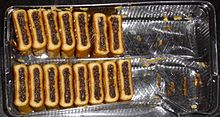 Homemade fig rolls | |
| Type | Pastry |
|---|---|
| Place of origin | Western Asia |
| Main ingredients | Fig paste |
The fig roll or fig bar is a biscuit or cookie consisting of a rolled cake or pastry filled with fig paste.
 Homemade fig rolls | |
| Type | Pastry |
|---|---|
| Place of origin | Western Asia |
| Main ingredients | Fig paste |
The fig roll or fig bar is a biscuit or cookie consisting of a rolled cake or pastry filled with fig paste.
Figs are a popular snack food in most of the world. Originating in northern Asia Minor, traded by the sailors and explorers of the region, they became popular in the Southern and hence hotter parts of the Mediterranean.[citation needed].
Figs were highly traded and fought over during the development of the great trade routes during the 15th to 17th centuries. Christopher Columbus devoted a complete page to what a wonderful time it would be when he would be able to gorge himself on figs in the orient, while Marco Polo described women in association with the beauty of figs. It was also during this period that figs reached America, when the Spanish reached the island of Hispaniola in 1520.[1]


In 1892 James Henry Mitchell, a Florida engineer and inventor, received a patent for a machine that could produce a hollow tube of cookie dough and simultaneously fill it with jam.[2][3][4] The machine consisted of two funnels, one inside the other, with the outer funnel creating the dough tube and the inner funnel filling that tube with fig jam.[4]
At the same time, Philadelphia baker and fig lover Charles Roser was developing a recipe for a pastry based on the homemade fig roll likely brought to the US by immigrants from Britain.[2][4] Roser approached the Cambridgeport, Massachusetts based Kennedy Biscuit Company, who agreed to take on production and sales.[2]
Kennedy Biscuit Company had recently become associated with the New York Biscuit Company, and after merger to form Nabisco, trademarked the product as the Fig Newton.[2] The cookie was named after the Massachusetts town of Newton.[4] It was one of the first commercially-produced baked goods in the United States.[4]
| History | |
|---|---|
| Types | |
| Religious dietary laws and related terms | |
| Chefs | |
| Religious foods | |
| Ashkenazi breads | |
| Sephardi and Mizrahi breads | |
| Ethiopian Jewish breads | |
| Bagels and similar breads | |
| Pancakes | |
| Cakes and other desserts |
|
| Cookies | |
| Pastries | |
| Fried foods |
|
| Dumplings, pastas and grain dishes |
|
| Casseroles and savory baked dishes | |
| Snacks and other baked goods | |
| Sandwiches | |
| Egg dishes | |
| Meat dishes | |
| Fish dishes | |
| Salads and pickles | |
| Vegetable dishes | |
| Soups and stews | |
| Cheeses and other dairy products | |
| Condiments, dips and sauces | |
| Beverages | |
| Herbs, spices and seasonings | |
| Related lists | |
| National cuisines |
|
|---|---|
| Ethnic and regional cuisines | |
| Lists | |
| History | |
|---|---|
| Fruits and vegetables | |
| Other ingredients | |
| Cheeses | |
| Breads | |
| Salads |
|
| Pasta | |
| Fish | |
| Soups |
|
| Meat | |
| Sandwiches | |
| Dips and condiments | |
| Grains and side dishes | |
| Fried foods | |
| Desserts | |
| Alcohol | |
| Other drinks |
|
| Israeli restaurants domestically and abroad | |
| Beverages |
|
|---|---|
| Breads | |
| Appetizers and salads |
|
| Cheeses | |
| Soups | |
| Dishes |
|
| Grilled meats | |
| Desserts |
|
| Frequent ingredients | |
| Unique instruments | |
| Related cuisines | |
| Breads | |||||||||||||
|---|---|---|---|---|---|---|---|---|---|---|---|---|---|
| Cheeses | |||||||||||||
| Dried meats | |||||||||||||
| Dishes |
| ||||||||||||
| Desserts | |||||||||||||
| Drinks | |||||||||||||